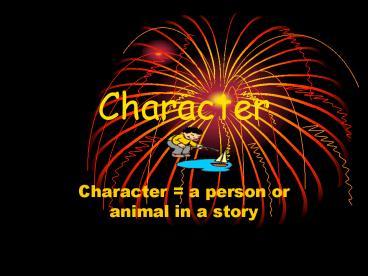Character - PowerPoint PPT Presentation
1 / 23
Title: Character
1
Character
- Character a person or animal in a story
2
Characterization
- The methods used by the author to create or
reveal the characters in a story. - (can be direct or indirect)
3
Direct Characterization
- The method of character development in which the
author simply tells you what the character is
like. For example, Miss Alice was the nicest
person you would ever want to meet, is direct
characterization.
4
Indirect Characterization
- The method of characterization that is most
similar to the way we learn about people in real
life. Using indirect characterization, the
author presents the characters personality
through what he/she says, his/her actions, or how
other characters relate to him/her. You must
then draw your own conclusions about the
character.
5
Example of Direct or Indirect Characterization?
- Read the following example of characterization.
Decide whether it is an example of direct or
indirect characterization. - (A) James was one of those people who was
constantly angry. He looked for trouble wherever
he went, and he usually found it.
6
Example of Direct or Indirect Characterization?
- Stanleys eyes blazed as he surveyed the room.
The corners of his mouth pointed in a decidedly
southerly direction. Carol moved aside as he
stalked past her. - Look out for Stan, she whispered to Bart.
Hes in another one of his moods. Id stay far
away if I were you!
7
Description A is an example of direct
characterization.
- The author comes right out and tells you that
James was always angry, and that he was looking
for a fight almost constantly.
8
Description B is an example of indirect
characterization.
- We can tell from his angry eyes, frowning mouth
and the way he walked that he is angry. We can
also see that others are somewhat frightened by
him by observing their reactions. Carol moves
aside and warns Bart to avoid Stanley.
9
- Which method is more effective in developing the
character? Why do you think so?
10
Methods of Characterizationcreating believable
characters
11
Types of Characters
- Major
- Minor
12
Major Character
- The major (main) character in a story is like the
star of a movie and is central to the action that
takes place.
13
Minor character
- A minor character is one who takes part in the
action but is not the focus of attention.
14
Types of Characters
- The protagonist (or main character) is the
central figure in the work. - The antagonist is the character or force pitted
against the protagonist.
15
More types of characters
- A static character does not change through the
course of the action. - A dynamic character is one who does change.
16
Dont forget the Stock Character
- A stock character (stereotype) is one found again
and again in literary works. An example of a
stock character is that of the mad scientist that
appears over and over in different works such
as Dr. Evil, Dr. No, or Dr. Frankenstein.
17
Round Character
- A round character is a complex, fully developed
character.
18
Flat Character
- A flat character is a one-dimensional character,
typically not central to the story
19
The protagonist is usually
- The central character
- A character the reader can identify with
- Has a rounded personality (we hear what they say,
what others say about them, we know what they
think and how they feel) - A character with a dynamic personality
20
Secondary characters are usually
- Static
- Flat
21
Character Motivation
- A motive is a reason that explains or partially
explains a characters thoughts, feelings,
actions, or speech. If the motives of a main
character are not clear, then the character will
not be believable. - Characters are often motivated by needs, such as
food and shelter. They are also motivated by
feelings, such as fear, love, and pride. Motives
may be obvious or hidden.
22
Characters Qualities or Traits
- The personal traits that make up the characters
personality.
23
Dialogue
- Dialogue is a conversation between two or more
people. Dialogue is usually set off by quotation
marks to indicate a speakers exact words.






























